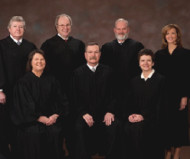2/3/2015
Kansas Supreme Court Limits Use Of Portable DUI TesterHigh court in Kansas compares DUI sobriety test to Magic 8 Ball and Ouija Board.

The Kansas Supreme Court on Friday slammed the use of the horizontal gaze nystagmus (HGN) test commonly given on the side of the road to motorists suspected of driving under the influence (DUI) of alcohol. The court made the point in reversing the conviction of William J. Molitor, a driver who showed few signs of intoxication and was only given a breath test after he failed the controversial eye test.
Nystagmus is the abnormal and involuntary jerking of the eyeballs as they track an object to the extreme range of their motion. The jerking movement tends to occur earlier for those who are either intoxicated or suffer from a number of different ailments. Police officers usually test for this by asking suspects to follow the motion of a penlight with their eyes.
On the evening of February 28, 2009, Wichita Police Officer Jeremy Diaz was staking out a local bar when he allegedly saw Molitor turn right without signaling. Molitor's driving raised so suspicion, though he brushed the curb after Officer Diaz ordered him to pull over.
Molitor admitted he had consumed a few beers that night, but his speech was not slurred. He maintained perfect balance and showed no sign of mental impairment. Officer Diaz had Molitor perform the standard field sobriety tests. Molitor successfully completed the walk-and-turn and one-leg stands tasks, but he failed the horizontal gaze nystagmus test.
Officer Diaz had Molitor use a preliminary breath tester, which showed the driver was just over the legal limit with an estimated blood alcohol content of 0.09. He was arrested and given an Intoxilyzer 8000 test, which confirmed the result. Molitor appealed, arguing that the only evidence Officer Diaz had of his intoxication was the unscientific HGN test.
"In this state, we have held that HGN is inadmissible because it has not been scientifically validated legally," Molitor's attorney, Michael P. Whalen, told the high court. "Therefore it is excluded evidence and not admissible in any situation.... If an officer is trained in Ouija board, and it comes up and says, 'Yes,' well, it's the same thing as using horizontal gaze nystagmus to request a preliminary breath test. This officer believes in it and relies on it."
Prosecutors countered that the lower standard of "reasonable suspicion" applied to the use of a portable breath tester, so the HGN test could be used. The unconvinced high court justices echoed Whalen's criticism.
"Should a court allow the officer to base reasonable suspicion upon the Ouija Board test results?" Justice Lee A. Johnson asked in his majority ruling. "Of course not. And at this point in the state of Kansas, the HGN test has no more credibility than a Ouija Board or a Magic 8 Ball. To change that circumstance, the state needs to prove the legitimacy of the test."
The court cited a number of studies and reasons to doubt that the HGN would ever be validated. Absent that validation, Officer Diaz did not have enough proof that Molitor was intoxicated.
"Here, the subjective observations which might suggest to Officer Diaz that Molitor was illegally intoxicated were offset by the objective indications that he was not," Justice Johnson wrote. "Indeed, if Molitor had failed the objectively scored SFSTs [field sobriety tests], one would suspect that the state would be arguing that the officer's trained observations were corroborated by the psychomotor testing."
A copy of the decision is available in a 75k PDF file at the source link below.


